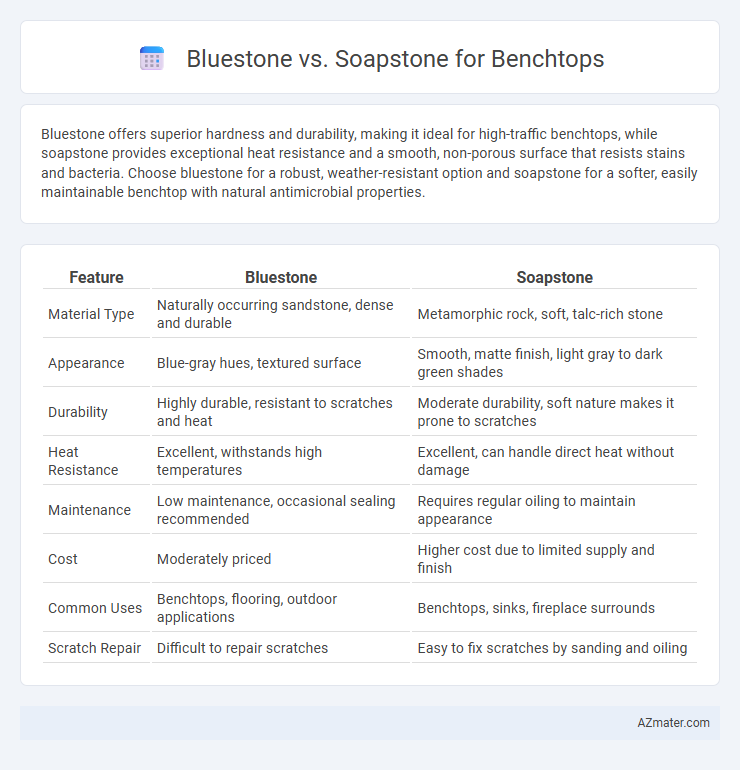Bluestone offers superior hardness and durability, making it ideal for high-traffic benchtops, while soapstone provides exceptional heat resistance and a smooth, non-porous surface that resists stains and bacteria. Choose bluestone for a robust, weather-resistant option and soapstone for a softer, easily maintainable benchtop with natural antimicrobial properties.
Table of Comparison
| Feature | Bluestone | Soapstone |
|---|---|---|
| Material Type | Naturally occurring sandstone, dense and durable | Metamorphic rock, soft, talc-rich stone |
| Appearance | Blue-gray hues, textured surface | Smooth, matte finish, light gray to dark green shades |
| Durability | Highly durable, resistant to scratches and heat | Moderate durability, soft nature makes it prone to scratches |
| Heat Resistance | Excellent, withstands high temperatures | Excellent, can handle direct heat without damage |
| Maintenance | Low maintenance, occasional sealing recommended | Requires regular oiling to maintain appearance |
| Cost | Moderately priced | Higher cost due to limited supply and finish |
| Common Uses | Benchtops, flooring, outdoor applications | Benchtops, sinks, fireplace surrounds |
| Scratch Repair | Difficult to repair scratches | Easy to fix scratches by sanding and oiling |
Introduction to Bluestone and Soapstone Benchtops
Bluestone benchtops offer exceptional durability and a natural blue-gray hue ideal for contemporary kitchens, while soapstone benchtops provide a softer, smooth surface with excellent heat resistance and a unique dark, matte finish. Both materials are dense, non-porous, and resistant to stains, making them practical choices for benchtops that require minimal maintenance. Their distinct aesthetic and physical properties cater to diverse design preferences and functional needs in kitchen environments.
Key Differences Between Bluestone and Soapstone
Bluestone benchtops are composed of dense sandstone with a slightly rough texture and high durability, making them resistant to outdoor weathering and heavy use. Soapstone, a metamorphic rock rich in talc, offers a smooth, non-porous surface that is highly heat-resistant and naturally antibacterial, ideal for kitchen benchtops requiring easy maintenance and stain resistance. While Bluestone boasts a blue-gray hue with subtle color variations, Soapstone typically presents a darker, matte finish with occasional veining and softens slightly over time, highlighting its natural patina.
Aesthetic Appeal: Looks and Styles
Bluestone benchtops showcase a sleek, modern appeal with their deep blue-grey hues and subtle veining, making them ideal for contemporary kitchens. Soapstone offers a softer, matte finish with warm, earthy tones that develop a unique patina over time, enhancing its natural charm. Both materials provide timeless elegance, but bluestone suits minimalist styles while soapstone complements rustic or traditional aesthetics.
Durability and Strength Comparison
Bluestone offers exceptional durability due to its dense, fine-grained texture, making it highly resistant to scratches and chips, ideal for high-traffic benchtops. Soapstone, while softer and more prone to nicks, has remarkable heat resistance and can be easily repaired by sanding out imperfections, ensuring long-term usability. Both materials provide strength in different contexts, with bluestone excelling in hardness and soapstone in thermal stability, influencing their performance as benchtop surfaces.
Maintenance Requirements
Bluestone benchtops require minimal maintenance, needing periodic sealing to prevent stains and maintain their natural luster. Soapstone surfaces demand regular oiling to enhance their rich, dark patina and protect against scratches, though they are inherently resistant to heat and chemicals. Both materials benefit from prompt cleaning with mild soap and water, but soapstone's softer nature means it shows wear more quickly, necessitating more frequent upkeep.
Heat and Stain Resistance
Bluestone offers superior heat resistance, making it ideal for kitchen benchtops exposed to hot pots and pans, while soapstone also withstands high temperatures but may darken with prolonged heat exposure. Soapstone provides excellent stain resistance due to its non-porous nature, requiring less sealing than bluestone, which is more porous and susceptible to staining without regular maintenance. Both stones offer durable surfaces, but soapstone's natural resistance to acids and oils makes it a preferred choice for stain-prone environments.
Installation Process and Complexity
Bluestone benchtops require professional installation due to their dense, heavy nature and precise cutting requirements, demanding specialized tools and expertise. Soapstone, being softer and more malleable, allows for easier customization and can sometimes be installed by experienced DIYers, although professional fitting ensures better long-term durability. Both materials necessitate careful handling, but soapstone's lower brittleness reduces the risk of cracking during installation compared to bluestone.
Cost Analysis: Bluestone vs Soapstone
Bluestone countertops typically cost between $50 and $100 per square foot, offering a durable yet affordable option for kitchens and bathrooms. Soapstone ranges from $70 to $120 per square foot, reflecting its unique heat resistance and non-porous properties which reduce maintenance costs over time. While initial investment in soapstone is higher, its long-term durability and lower upkeep expenses can provide better value compared to bluestone.
Eco-Friendliness and Sustainability
Bluestone and soapstone are both eco-friendly benchtop materials, but soapstone is often considered more sustainable due to its natural, non-toxic composition and exceptional durability that reduces the need for replacement. Bluestone, a dense sandstone, requires quarrying that can have a higher environmental impact compared to soapstone, which is easier to source responsibly. Soapstone's resistance to staining and heat also extends the benchtop's lifespan, minimizing waste and promoting long-term sustainability in kitchen design.
Which Stone is Best for Your Benchtop?
Bluestone and soapstone both offer durability and aesthetic appeal for benchtops, but bluestone stands out for its hardness, resistance to scratches, and modern, sleek appearance, making it ideal for high-traffic kitchens. Soapstone provides excellent heat resistance and a softer, warmer look with natural veining, but it requires regular oiling and is more prone to scratches and dents. Choosing between bluestone and soapstone depends on whether you prioritize low maintenance and scratch resistance or a more classic, rustic charm with natural patina development.

Infographic: Bluestone vs Soapstone for Benchtop
 azmater.com
azmater.com